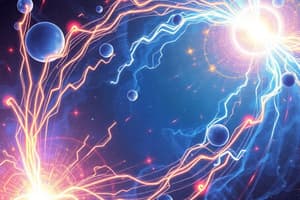Podcast
Questions and Answers
What is the primary function of the gravitational force in physics?
What is the primary function of the gravitational force in physics?
- Govern motion of planets and objects on Earth (correct)
- Responsible for nuclear fusion in stars
- Attraction between charged particles
- Binding protons and neutrons in atomic nuclei
Which equation represents Newton's second law of motion?
Which equation represents Newton's second law of motion?
- Force = mass × acceleration (correct)
- Force = velocity ÷ time
- Force = mass × displacement
- Force = mass × velocity
What is the primary concept described by the laws of thermodynamics?
What is the primary concept described by the laws of thermodynamics?
- Heat transfer only occurs through conduction
- Energy cannot be created or destroyed, only transformed (correct)
- Entropy of an isolated system decreases
- Energy can be created and destroyed
Which statement accurately describes electromagnetic waves?
Which statement accurately describes electromagnetic waves?
What is Ohm's Law used to relate?
What is Ohm's Law used to relate?
Which concept is NOT part of quantum mechanics?
Which concept is NOT part of quantum mechanics?
What phenomenon is explained by Einstein's theory of general relativity?
What phenomenon is explained by Einstein's theory of general relativity?
What is the main focus of cosmology?
What is the main focus of cosmology?
Flashcards are hidden until you start studying
Study Notes
Key Concepts in Physics
1. Fundamental Forces
- Gravitational Force: Attraction between masses; governs motion of planets and objects on Earth.
- Electromagnetic Force: Interaction between charged particles; responsible for electricity, magnetism, and light.
- Weak Nuclear Force: Responsible for radioactive decay and nuclear fusion in stars.
- Strong Nuclear Force: Binds protons and neutrons in atomic nuclei.
2. Classical Mechanics
- Newton's Laws of Motion:
- An object at rest stays at rest, and an object in motion stays in motion unless acted upon by a force.
- Force equals mass times acceleration (F = ma).
- For every action, there is an equal and opposite reaction.
- Kinematics: Describes motion of objects; includes concepts of velocity, acceleration, displacement, and time.
- Work and Energy:
- Work (W) = Force (F) × Distance (d) × cos(θ)
- Kinetic Energy (KE) = 1/2 mv²
- Potential Energy (PE) = mgh
3. Thermodynamics
- Laws of Thermodynamics:
- Energy cannot be created or destroyed, only transformed (Conservation of Energy).
- Entropy of an isolated system always increases.
- Absolute zero is unattainable.
- Heat Transfer: Conduction, convection, and radiation.
4. Waves and Oscillations
- Wave Properties: Wavelength, frequency, amplitude, speed.
- Types of Waves:
- Mechanical Waves: Require a medium (e.g., sound waves).
- Electromagnetic Waves: Do not require a medium (e.g., light waves).
- Simple Harmonic Motion: Characterized by sinusoidal oscillations (e.g., pendulum motion).
5. Electricity and Magnetism
- Ohm's Law: Voltage (V) = Current (I) × Resistance (R).
- Circuits: Series and parallel configurations; Kirchhoff's laws.
- Magnetic Fields: Produced by moving charges; described by Lorentz force.
6. Modern Physics
- Quantum Mechanics: Describes behavior of particles at atomic and subatomic levels; includes concepts like wave-particle duality and uncertainty principle.
- Relativity:
- Special Relativity: Time dilation and length contraction at high speeds; mass-energy equivalence (E=mc²).
- General Relativity: Gravity as curvature of spacetime.
7. Astrophysics
- Celestial Mechanics: Study of motions of celestial objects under gravitational influence.
- Cosmology: Study of the universe's origin, evolution, and eventual fate; includes the Big Bang theory.
Important Units and Measurements
- SI Units:
- Mass: kilogram (kg)
- Length: meter (m)
- Time: second (s)
- Force: Newton (N)
- Energy: Joule (J)
Problem-Solving Techniques
- Dimensional Analysis: Checking equations for consistency in units.
- Free Body Diagrams: Visualizing forces acting on an object to analyze motion.
- Conservation Laws: Using conservation of energy and momentum to solve problems.
Fundamental Forces
- Gravitational Force: Attraction between masses; essential for planetary motion and objects on Earth.
- Electromagnetic Force: Governs interaction among charged particles; crucial for phenomena like electricity, magnetism, and light.
- Weak Nuclear Force: Key player in radioactive decay and the process of nuclear fusion within stars.
- Strong Nuclear Force: Responsible for holding protons and neutrons together in atomic nuclei.
Classical Mechanics
- Newton's Laws of Motion:
- Objects remain at rest or in uniform motion unless a force acts on them.
- Force is calculated as the product of mass and acceleration (F = ma).
- For every action, there is an equal and opposite reaction.
- Kinematics: Studies the motion of objects, considering key variables like velocity, acceleration, displacement, and time.
- Work and Energy:
- Work (W) is defined as the product of force (F) and distance (d), taking the angle into account (cos(θ)).
- Kinetic Energy (KE) is measured by the formula KE = 1/2 mv², where m is mass and v is velocity.
- Potential Energy (PE) is given by PE = mgh, involving mass (m), height (h), and gravitational acceleration (g).
Thermodynamics
- Laws of Thermodynamics:
- Energy conservation indicates energy cannot be created or destroyed, only transformed.
- Entropy in isolated systems always tends to increase.
- Absolute zero, the theoretical lowest temperature, is unachievable.
- Heat Transfer Methods: Heat can be transferred through conduction, convection, and radiation.
Waves and Oscillations
- Wave Properties: Fundamental characteristics include wavelength, frequency, amplitude, and speed.
- Types of Waves:
- Mechanical Waves necessitate a medium for travel, such as sound waves.
- Electromagnetic Waves can travel through a vacuum, exemplified by light waves.
- Simple Harmonic Motion: Exhibits sinusoidal oscillations, as seen in systems like pendulums.
Electricity and Magnetism
- Ohm's Law: Establishes the relationship between voltage (V), current (I), and resistance (R) with the equation V = I × R.
- Circuit Types: Circuits can be configured in series or parallel; Kirchhoff's laws apply for analyzing circuit behavior.
- Magnetic Fields: Generated by moving charges and characterized by the Lorentz force.
Modern Physics
- Quantum Mechanics: Explores atomic and subatomic particle behavior, including principles like wave-particle duality and the uncertainty principle.
- Relativity:
- Special Relativity includes phenomena such as time dilation and length contraction, along with the mass-energy equivalence principle E=mc².
- General Relativity interprets gravity through the curvature of spacetime.
Astrophysics
- Celestial Mechanics: Examines the motion of celestial bodies influenced by gravitational forces.
- Cosmology: Investigates the universe's origin, development, and ultimate destiny, prominently featuring the Big Bang theory.
Important Units and Measurements
- Standard International (SI) Units:
- Mass: kilogram (kg)
- Length: meter (m)
- Time: second (s)
- Force: Newton (N)
- Energy: Joule (J)
Problem-Solving Techniques
- Dimensional Analysis: Ensures consistency of units in equations to validate their correctness.
- Free Body Diagrams: Visual tools to illustrate the forces acting on an object for motion analysis.
- Conservation Laws: Utilize principles of energy and momentum conservation to resolve problems effectively.
Studying That Suits You
Use AI to generate personalized quizzes and flashcards to suit your learning preferences.




